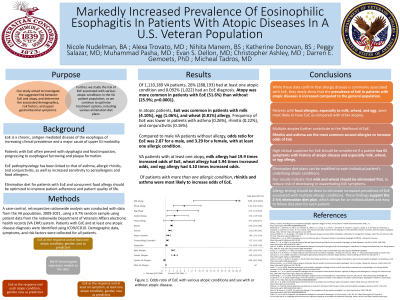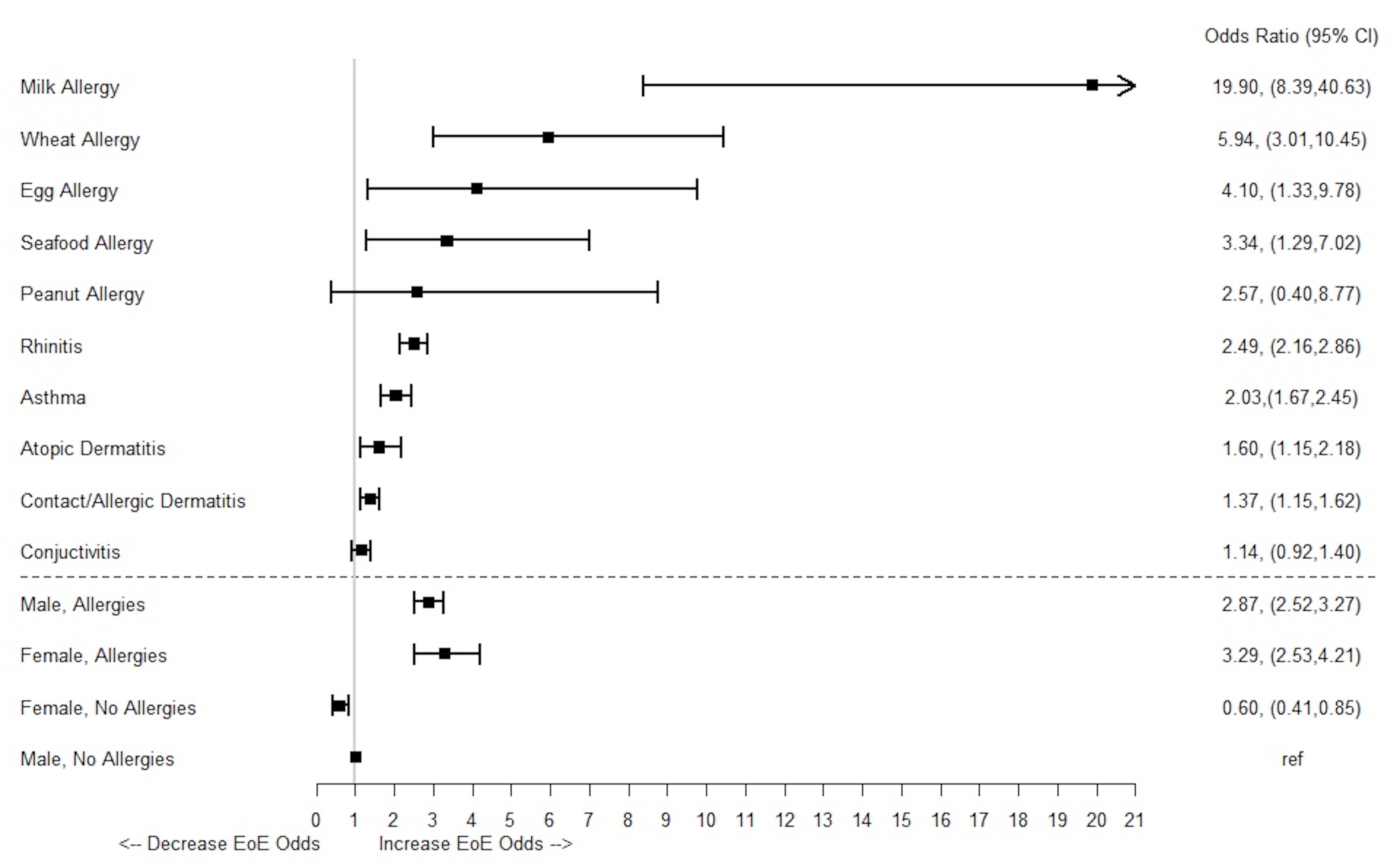Back


Poster Session E - Tuesday Afternoon
Category: Esophagus
E0197 - Markedly Increased Prevalence of Eosinophilic Esophagitis in Patients With Atopic Diseases in a U.S. Veteran Population
Tuesday, October 25, 2022
3:00 PM – 5:00 PM ET
Location: Crown Ballroom

Has Audio

Nicole T. Nudelman, BA
Albany Medical College
Albany, NY
Presenting Author(s)
Nicole T. Nudelman, BA1, Alexa Trovato, MD2, Nihita Manem, BS1, Katherine Donovan, BS1, Peggy E. Salazar, MD3, Muhammad Pasha, MD1, Evan Dellon, MD, MPH4, Christopher Ashley, MD, MPH, FACG5, Darren Gemoets, PhD5, Micheal Tadros, MD6
1Albany Medical College, Albany, NY; 2Boston Medical Center, Boston, MA; 3Albany Medical Center, Pembroke Pines, FL; 4University of North Carolina School of Medicine, Chapel Hill, NC; 5Stratton VA Medical Center, Albany, NY; 6Albany Medical Center, Albany, NY
Introduction: Eosinophilic Esophagitis (EoE) is a chronic esophageal disorder associated with atopy. However, there is lack of data on prevalence of EoE in atopic patients. We aimed to study the relationship between EoE and atopy to determine prevalence-associated demographics, risk factors, and symptoms.
Methods: A case-control study was conducted with data from the VA population, 2009-2021, using a 9.7% random sample from a nationwide VHA database. Demographic data, symptoms, and risk factors were collected on patients with EoE and at least one atopic disease diagnosis, identified using ICD9/10 codes. Logistic regression models for EoE, allergy, and symptoms were developed.
Results: Of 1,110,189 VA patients, 26% (288,193) had at least one atopic condition and 0.092% (1,022) had an EoE diagnosis. Atopy was more common in patients with EoE (51.6%) than without (25.9%; p< 0.0001).
In atopic patients, EoE was common in patients with milk (4.10%), egg (1.06%), and wheat (0.81%) allergy. Frequency of EoE was lower in patients with asthma (0.26%), rhinitis (0.22%), and conjunctivitis (0.16%). In patients with EoE, rhinitis (32.5%), dermatitis (18.4%), and asthma (12.7%) were most common. Few patients with EoE had wheat (1.04%), milk (0.78%) or egg (0.49%) allergy.
Atopic patients had increased odds of EoE (Figure 1). Compared to male VA patients without allergy, odds ratio for EoE was 2.87 for a male and 3.29 for a female, each with at least one allergic condition. In a separate model, VA patients with at least one atopic condition, milk allergy had 19.9 times increased odds of EoE, wheat allergy had 5.94 times increased odds, and egg allergy had 4.10 times increased odds. Of patients with more than one allergic condition, rhinitis and asthma were most likely to increase odds of EoE. VA patients presenting with upper GI symptoms had higher odds of EoE (24.41), or EoE and allergy comorbidity (45.98) compared to patients without symptoms.
Discussion: While these data confirm that atopy is commonly associated with EoE, they newly show increased prevalence of EoE in atopic patients. Patients with food allergy, especially to milk, wheat, and egg, are most likely to have EoE. Upper GI symptoms are more likely to indicate EoE and allergy comorbidity, or EoE alone, than at least one atopic disease. Thus, high clinical suspicion for EoE should be considered if a patient has GI symptoms with history of atopic disease and especially milk, wheat, or egg allergy.

Disclosures:
Nicole T. Nudelman, BA1, Alexa Trovato, MD2, Nihita Manem, BS1, Katherine Donovan, BS1, Peggy E. Salazar, MD3, Muhammad Pasha, MD1, Evan Dellon, MD, MPH4, Christopher Ashley, MD, MPH, FACG5, Darren Gemoets, PhD5, Micheal Tadros, MD6. E0197 - Markedly Increased Prevalence of Eosinophilic Esophagitis in Patients With Atopic Diseases in a U.S. Veteran Population, ACG 2022 Annual Scientific Meeting Abstracts. Charlotte, NC: American College of Gastroenterology.
1Albany Medical College, Albany, NY; 2Boston Medical Center, Boston, MA; 3Albany Medical Center, Pembroke Pines, FL; 4University of North Carolina School of Medicine, Chapel Hill, NC; 5Stratton VA Medical Center, Albany, NY; 6Albany Medical Center, Albany, NY
Introduction: Eosinophilic Esophagitis (EoE) is a chronic esophageal disorder associated with atopy. However, there is lack of data on prevalence of EoE in atopic patients. We aimed to study the relationship between EoE and atopy to determine prevalence-associated demographics, risk factors, and symptoms.
Methods: A case-control study was conducted with data from the VA population, 2009-2021, using a 9.7% random sample from a nationwide VHA database. Demographic data, symptoms, and risk factors were collected on patients with EoE and at least one atopic disease diagnosis, identified using ICD9/10 codes. Logistic regression models for EoE, allergy, and symptoms were developed.
Results: Of 1,110,189 VA patients, 26% (288,193) had at least one atopic condition and 0.092% (1,022) had an EoE diagnosis. Atopy was more common in patients with EoE (51.6%) than without (25.9%; p< 0.0001).
In atopic patients, EoE was common in patients with milk (4.10%), egg (1.06%), and wheat (0.81%) allergy. Frequency of EoE was lower in patients with asthma (0.26%), rhinitis (0.22%), and conjunctivitis (0.16%). In patients with EoE, rhinitis (32.5%), dermatitis (18.4%), and asthma (12.7%) were most common. Few patients with EoE had wheat (1.04%), milk (0.78%) or egg (0.49%) allergy.
Atopic patients had increased odds of EoE (Figure 1). Compared to male VA patients without allergy, odds ratio for EoE was 2.87 for a male and 3.29 for a female, each with at least one allergic condition. In a separate model, VA patients with at least one atopic condition, milk allergy had 19.9 times increased odds of EoE, wheat allergy had 5.94 times increased odds, and egg allergy had 4.10 times increased odds. Of patients with more than one allergic condition, rhinitis and asthma were most likely to increase odds of EoE. VA patients presenting with upper GI symptoms had higher odds of EoE (24.41), or EoE and allergy comorbidity (45.98) compared to patients without symptoms.
Discussion: While these data confirm that atopy is commonly associated with EoE, they newly show increased prevalence of EoE in atopic patients. Patients with food allergy, especially to milk, wheat, and egg, are most likely to have EoE. Upper GI symptoms are more likely to indicate EoE and allergy comorbidity, or EoE alone, than at least one atopic disease. Thus, high clinical suspicion for EoE should be considered if a patient has GI symptoms with history of atopic disease and especially milk, wheat, or egg allergy.

Figure: Figure 1. Odds ratios of developing EoE for sex and atopic disease conditions.
Disclosures:
Nicole Nudelman indicated no relevant financial relationships.
Alexa Trovato indicated no relevant financial relationships.
Nihita Manem indicated no relevant financial relationships.
Katherine Donovan indicated no relevant financial relationships.
Peggy Salazar indicated no relevant financial relationships.
Muhammad Pasha indicated no relevant financial relationships.
Evan Dellon: Abbott – Consultant. Abbvie – Consultant. Adare Pharma Solutions – Consultant, Grant/Research Support. Aimmune Therapeutics – Consultant. Allakos – Consultant, Grant/Research Support, Educational grant. Amgen – Consultant. Arena Pharmaceuticals – Consultant, Grant/Research Support. AstraZeneca – Consultant, Grant/Research Support. Banner Pharmaceuticals – Grant/Research Support. Biorasi – Consultant. Calypso Biotech – Consultant. Eli Lilly – Consultant. EsoCap – Consultant. Gossamer Bio – Consultant. GSK – Consultant, Grant/Research Support. Holoclara – Grant/Research Support. Invea Therapeutics – Consultant. Landos Biopharma – Consultant. Lucid Diagnostics – Consultant. LucidDX – Consultant. Meritage Pharma – Consultant, Grant/Research Support. Miraca Life Sciences – Consultant, Grant/Research Support. Morphic Therapeutic – Consultant. Nutricia – Consultant, Grant/Research Support. Parexel/Calyx – Consultant. Phathom Pharmaceuticals – Consultant. Receptos/BMS – Consultant, Grant/Research Support. Regeneron Pharmaceuticals, Inc. – Consultant, Grant/Research Support. Revolo Bio – Consultant. Robarts Clinical Trials/Alimentiv – Consultant. Salix Pharmaceuticals – Consultant. Sanofi – Consultant. Shire/Takeda – Consultant, Grant/Research Support. Target RWE/Ellodi Pharmaceuticals – Consultant.
Christopher Ashley indicated no relevant financial relationships.
Darren Gemoets indicated no relevant financial relationships.
Micheal Tadros indicated no relevant financial relationships.
Nicole T. Nudelman, BA1, Alexa Trovato, MD2, Nihita Manem, BS1, Katherine Donovan, BS1, Peggy E. Salazar, MD3, Muhammad Pasha, MD1, Evan Dellon, MD, MPH4, Christopher Ashley, MD, MPH, FACG5, Darren Gemoets, PhD5, Micheal Tadros, MD6. E0197 - Markedly Increased Prevalence of Eosinophilic Esophagitis in Patients With Atopic Diseases in a U.S. Veteran Population, ACG 2022 Annual Scientific Meeting Abstracts. Charlotte, NC: American College of Gastroenterology.
